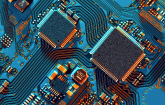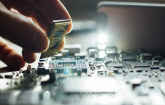
BANGALORE, India, Oct. 22, 2025 /PRNewswire/ -- Extreme Ultraviolet Lithography (EUL) Market is Segmented by Type (Light Source, Mirror, Mask), by Application (Integrated Device Manufacturers (IDM), Foundry)
What is the Market Size of Extreme Ultraviolet Lithography (EUL)?
The global market for Extreme Ultraviolet Lithography (EUL) was valued at USD 7267 Million in the year 2024 and is projected to reach a revised size of USD 28660 Million by 2031, growing at a CAGR of 22.0% during the forecast period.
What are the key factors driving the growth of the Extreme Ultraviolet Lithography Market?
- The Extreme Ultraviolet Lithography (EUV) Market is evolving as a cornerstone of advanced semiconductor manufacturing.
- EUV offers precision, scalability, and integration potential, making it essential for next-generation electronics.
- Widespread industry adoption indicates growing confidence in EUV's reliability and efficiency.
- Continuous improvements in light source stability, mask quality, and tool productivity sustain market competitiveness.
- The market benefits from digitalization, global investments, and collaboration among key industry players.
- Increasing semiconductor demand across computing, communication, and automotive sectors drives EUV adoption.
- EUV remains at the forefront of lithography innovation, shaping the future of microfabrication.
- It maintains its position as the technology standard for miniaturization.
Source from Valuates Reports: https://reports.valuates.com/market-reports/QYRE-Auto-11F8888/global-extreme-ultraviolet-lithography-eul?utm_source=prnewswire&utm_medium=referral
TRENDS INFLUENCING THE GROWTH OF THE EXTREME ULTRAVIOLET LITHOGRAPHY [EUL] MARKET:
Light sources act as the foundation of the Extreme Ultraviolet Lithography (EUL) Market by enabling chipmakers to achieve higher precision in semiconductor patterning. These advanced light sources generate extremely short wavelengths that allow for the creation of smaller and more complex integrated circuits. Manufacturers adopt high-intensity light systems that improve throughput and consistency, reducing defects and enhancing yield. As chip designs become denser and more efficient, reliable EUV light generation ensures optimal resolution and pattern accuracy. The continued refinement of light source technologies supports next-generation device fabrication, empowering semiconductor companies to meet the demands of artificial intelligence, high-performance computing, and data-centric applications that define the modern electronics ecosystem.
Masks drive the Extreme Ultraviolet Lithography (EUL) Market by shaping the intricate patterns required for next-generation semiconductor production. EUV masks transfer fine circuit designs onto wafers with exceptional precision, defining transistor structures at nanometer scales. The evolution of mask materials and defect control systems enhances overall chip quality and reliability. Manufacturers invest heavily in reflective and defect-free mask blanks to optimize production efficiency. As device geometries shrink, the importance of precision mask engineering increases to ensure high pattern fidelity. The development of pellicle technologies also supports mask protection during exposure, reducing contamination risks and ensuring consistent output that accelerates mass-scale chip manufacturing worldwide.
Foundries play a crucial role in the Extreme Ultraviolet Lithography (EUL) Market by being the primary adopters of EUV systems for advanced semiconductor fabrication. These facilities drive innovation by integrating EUV technology into their production lines to achieve higher transistor density and reduced power consumption. Foundries invest in EUV to remain competitive and cater to clients demanding performance-driven chips. Their operational expertise supports large-scale implementation, setting benchmarks for yield optimization and cost efficiency. Collaboration between equipment suppliers and foundries ensures continuous improvement in EUV tool uptime and process stability, ultimately expanding the application of EUV lithography across multiple semiconductor generations and device architectures in global manufacturing hubs.
The push toward smaller, faster, and more power-efficient chips strongly fuels the Extreme Ultraviolet Lithography (EUL) Market. EUV technology enables unprecedented scaling by patterning fine circuit geometries beyond the limits of deep ultraviolet methods. As demand for compact devices grows in consumer electronics and computing, chipmakers rely on EUV to sustain Moore's law. Its precision allows higher transistor density without compromising performance. The market benefits from this continuous drive for miniaturization, as companies transition to next-generation nodes. The need for greater efficiency in artificial intelligence, 5G communication, and data processing further strengthens EUV's role as the preferred lithography platform in advanced semiconductor production.
The EUL Market expands significantly due to growing demand from data centers and artificial intelligence applications requiring highly advanced semiconductors. EUV lithography enables production of processors and memory chips capable of handling complex computational workloads efficiently. As cloud computing, machine learning, and big data operations proliferate, companies require higher-performing and energy-efficient chips. EUV allows manufacturers to achieve the necessary density and speed for these processors. Data-driven industries rely on this capability to meet evolving technological standards. The adoption of EUV in producing AI accelerators and advanced memory architectures thus enhances productivity and supports the continuous evolution of global digital infrastructure.
Large-scale investments in semiconductor manufacturing are key drivers of the Extreme Ultraviolet Lithography (EUL) Market. Governments and private enterprises are expanding domestic fabrication capacities to ensure technological sovereignty and reduce supply chain risks. EUV lithography stands at the center of these initiatives as the essential technology for cutting-edge chip production. Funding supports infrastructure, research, and workforce training, accelerating adoption of EUV tools in new fabs. These investments encourage collaborations between lithography equipment makers and chip manufacturers, strengthening the ecosystem. The resulting industrial growth ensures stable demand for EUV systems, cementing their role as strategic assets in the semiconductor value chain.
The consolidation of semiconductor supply chains and formation of strategic partnerships boost the growth of the EUL Market. Equipment manufacturers, material suppliers, and foundries collaborate to overcome technical challenges and optimize EUV performance. Partnerships enable knowledge exchange that accelerates defect reduction, throughput improvement, and cost management. The integration of complementary technologies through alliances ensures smoother production processes and innovation sharing. Collaborative frameworks also help standardize procedures across regions, promoting global adoption. These industry relationships strengthen resilience and scalability, supporting faster commercialization of EUV lithography solutions that power the next wave of semiconductor advancements across multiple sectors.
EUL technology benefits from rising emphasis on yield optimization and quality assurance in chip manufacturing. High-quality wafers demand precise pattern alignment and defect-free production, achievable through EUV's superior resolution. Manufacturers deploy advanced metrology tools alongside EUV systems to ensure consistent outcomes. Quality-driven process control not only enhances profitability but also minimizes material wastage. As production nodes continue to shrink, error margins become narrower, increasing the importance of reliable lithography performance. Continuous monitoring and feedback-driven optimization empower chipmakers to achieve consistent yields, reinforcing confidence in EUV adoption as a dependable and efficient lithography solution for future semiconductor generations.
The growing complexity of integrated circuits across consumer and industrial devices intensifies EUV demand. Modern applications such as autonomous vehicles, quantum computing, and edge processing require semiconductors with sophisticated architecture and multi-layered design. EUV lithography enables manufacturers to produce intricate patterns essential for such applications. The technology's precision facilitates integration of diverse functionalities within a single chip, reducing form factor while improving performance. As device requirements evolve, EUV continues to serve as the enabler for high-complexity circuits that power next-generation systems. This continuous shift toward advanced design integration consolidates EUV's dominance in global semiconductor manufacturing.
Claim Yours Now! https://reports.valuates.com/api/directpaytoken?rcode=QYRE-Auto-11F8888&lic=single-user
Which region dominates the Extreme ultraviolet lithography market?
North America leads through innovation and high-end foundry investments. Europe focuses on research collaborations and sustainability-driven manufacturing. Asia-Pacific dominates production volume due to its expanding semiconductor ecosystem and governmental backing.
Key Companies:
- ASML – The global leader in EUV lithography systems, providing cutting-edge tools for advanced semiconductor manufacturing.
- Nikon – Develops high-precision lithography equipment and supports next-generation semiconductor production with EUV-compatible technologies.
- Canon – Focuses on R&D and production of photolithography systems, contributing to EUV and advanced semiconductor processes.
- Carl Zeiss – Supplies precision optical components and EUV optics critical for lithography tool performance.
- Toppan Printing – Specializes in photomask production, a key enabler for EUV semiconductor patterning.
- NTT Advanced Technology – Provides EUV-related materials, inspection, and metrology solutions for semiconductor fabrication.
- Intel – Integrates EUV lithography into its semiconductor manufacturing to enable advanced node production.
- Samsung – Implements EUV technology in high-volume production of advanced memory and logic chips.
- SK Hynix – Uses EUV lithography to enhance memory chip manufacturing at advanced process nodes.
- Toshiba – Engages in EUV adoption for semiconductor R&D and memory chip innovation.
- TSMC – Leads in high-volume EUV adoption for logic and advanced semiconductor fabrication.
- Globalfoundries – Explores EUV integration for advanced node development and specialty semiconductor solutions.
SUBSCRIPTION
We have introduced a tailor-made subscription for our customers. Please leave a note in the Comment Section to know about our subscription plans.
What are some related markets to the Extreme ultraviolet lithography market?
- Extreme Ultraviolet Lithography Technology Market
- Extreme Ultraviolet Lithography Mask Blanks Market was valued at USD 75.6 Million in the year 2024 and is projected to reach a revised size of USD 122 Million by 2031, growing at a CAGR of 7.2% during the forecast period.
- Extreme Ultraviolet (EUV) Flat Mirror Market
- Extreme Ultraviolet (EUV) Photoresist Market
- EUV Light Sources Market was valued at USD 215 Million in the year 2024 and is projected to reach a revised size of USD 380 Million by 2031, growing at a CAGR of 8.6% during the forecast period.
- EUV Mask Defect Inspection Equipment Market was valued at USD 1645 Million in the year 2024 and is projected to reach a revised size of USD 3863 Million by 2031, growing at a CAGR of 13.2% during the forecast period.
- IC Front-end Lithography Market was valued at USD 27060 Million in the year 2024 and is projected to reach a revised size of USD 42840 Million by 2031, growing at a CAGR of 6.9% during the forecast period.
- Materials for Next-generation Lithography Market
- Maskless Laser Lithography Market
- KrF Lithography Market was valued at USD 3354 Million in the year 2024 and is projected to reach a revised size of USD 4963 Million by 2031, growing at a CAGR of 5.8% during the forecast period.
- Lithography Equipment Market was valued at USD 341 Million in the year 2024 and is projected to reach a revised size of USD 773 Million by 2031, growing at a CAGR of 12.6% during the forecast period.
DISCOVER OUR VISION: VISIT ABOUT US!
Valuates offers in-depth market insights into various industries. Our extensive report repository is constantly updated to meet your changing industry analysis needs.
Our team of market analysts can help you select the best report covering your industry. We understand your niche region-specific requirements and that's why we offer customization of reports. With our customization in place, you can request for any particular information from a report that meets your market analysis needs.
To achieve a consistent view of the market, data is gathered from various primary and secondary sources, at each step, data triangulation methodologies are applied to reduce deviance and find a consistent view of the market. Each sample we share contains a detailed research methodology employed to generate the report. Please also reach our sales team to get the complete list of our data sources.
Contact Us
Valuates Reports
[email protected]
For U.S. Toll-Free Call 1-(315)-215-3225
WhatsApp: +91-9945648335
Explore our blogs & channels:
Blog: https://valuatestrends.blogspot.com/
Pinterest: https://in.pinterest.com/valuatesreports/
Twitter: https://twitter.com/valuatesreports
Facebook: https://www.facebook.com/valuatesreports/
YouTube: https://www.youtube.com/@valuatesreports6753
Localized content:
Korean: https://www.facebook.com/valuateskorean
Spanish: https://www.facebook.com/valuatesspanish
Japanese: https://www.facebook.com/valuatesjapanese
Spanish: https://valuatesreportspanish.blogspot.com/
Korean: https://valuateskorean.blogspot.com/
German: https://valuatesgerman.blogspot.com/
Japanese: https://valuatesreportjapanese.blogspot.com/
Logo: https://mma.prnewswire.com/media/1082232/Valuates_Reports_Logo.jpg
SOURCE Valuates Reports






Share this article